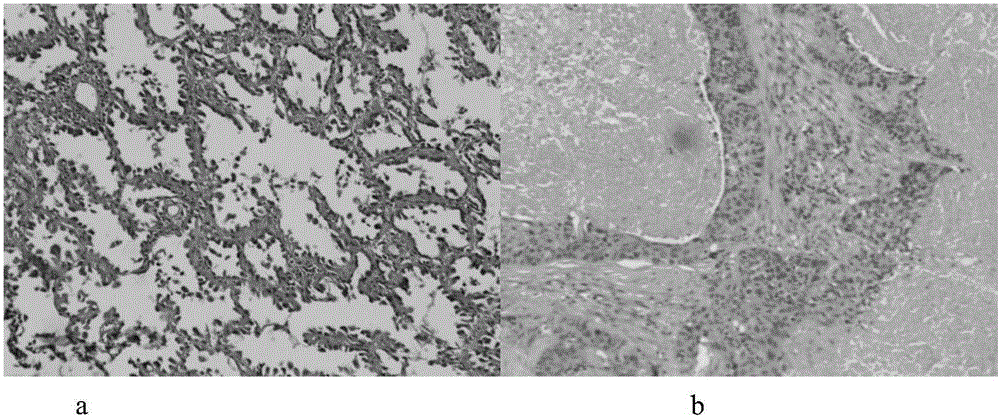Plasma metabolization micromolecule marker related to human non-small-cell lung cancer and application of plasma metabolization micromolecule marker
A technology for non-small cell lung cancer and metabolic small molecules, which is applied in the fields of analytical chemistry and clinical medicine, can solve problems such as complex experimental steps, low sensitivity, and narrow detection dynamic range, so as to improve sensitivity and specificity, facilitate detection, and avoid Effect of Invasive Diagnostics
- Summary
- Abstract
- Description
- Claims
- Application Information
AI Technical Summary
Problems solved by technology
Method used
Image
Examples
Embodiment 1
[0073] Example 1 Research object selection and grouping basis
[0074] The inventors collected blood samples from patients with non-small cell lung cancer and healthy controls that met the requirements from the First Affiliated Hospital of Nanjing Medical University from October 2011 to June 2014. of 112 healthy controls (mean age: 58.5 years, range 42-80 years) and 99 patients with non-small cell lung cancer (mean age: 59.5 years, range 42-83 years) as metabolic small molecule biomarkers for non-small cell lung cancer Object screening test objects. The specific sample classification standards are as follows:
[0075] Group A: healthy control group (n=112, 56 people were screened, 56 people were independently verified):
[0076] 1. Aged between 42 and 80 years old;
[0077] 2. No tumor was diagnosed by physical examination, and there was no previous history of tumor;
[0078] 3. No other major systemic diseases;
[0079] 4. No history of chronic disease with long-term med...
Embodiment 2
[0085] Example 2 The main diagnostic basis of the research object
[0086] The study aimed at patients who were initially diagnosed with non-small cell lung cancer by biopsy, biopsy, and cytopathology, and who had not undergone surgery, radiotherapy, or chemotherapy. The main diagnosis is based on: (1) chest CT imaging findings: see figure 2 ; (2) Results of puncture, biopsy, cytology and pathology: see figure 1 .
[0087] The above clinical examination methods all have their limitations. Among them, chest CT has high false-negative and false-positive results in the diagnosis of lung cancer, and radiological methods have certain radiation damage to lung cancer patients. Puncture, biopsy, and cytology methods are more accurate, but they are invasive diagnostic methods, and the patient is in the middle and late stages at the time of diagnosis, and the disease cannot be detected early. In clinical work, more patients are diagnosed by pathological examination of surgically resec...
Embodiment 3
[0088] Example 3 UPLC-MS Metabolomics Non-Small Cell Lung Cancer Biomarker Screening
[0089] 1. Sample pretreatment
[0090] 1. Centrifuge the fresh blood at 3000 rpm for 5 min, and dispense 400 μl of the supernatant into clean 1.5 ml EP tubes.
[0091] 2. 400 μl of plasma was used to precipitate proteins with 1200 μl of methanol.
[0092] 3. Aspirate the supernatant, divide into 2 equal parts, blow dry with nitrogen and then dry under vacuum.
[0093] 4. Dissolve one portion of the dry matter (acidic extract) with 50 μL of water (containing 0.1% formic acid) and the other dry matter with 50 μL of water containing 6.5 mM ammonium bicarbonate pH=8 (alkaline extract).
[0094] 2. Instrument testing
[0095] 2.1 Analytical instrument: UPLC tandem ThermoFisherLTQ-FT linear ion trap cyclotron resonance mass spectrometer of WatersAcquity Company was used.
[0096] 2.2 Liquid phase conditions:
[0097] 2.2.1 The liquid chromatography column is WatersBEHC181.7μm100mm chromatogra...
PUM
| Property | Measurement | Unit |
|---|---|---|
| molecular weight | aaaaa | aaaaa |
| Sensitivity | aaaaa | aaaaa |
| Sensitivity | aaaaa | aaaaa |
Abstract
Description
Claims
Application Information
 Login to View More
Login to View More - R&D
- Intellectual Property
- Life Sciences
- Materials
- Tech Scout
- Unparalleled Data Quality
- Higher Quality Content
- 60% Fewer Hallucinations
Browse by: Latest US Patents, China's latest patents, Technical Efficacy Thesaurus, Application Domain, Technology Topic, Popular Technical Reports.
© 2025 PatSnap. All rights reserved.Legal|Privacy policy|Modern Slavery Act Transparency Statement|Sitemap|About US| Contact US: help@patsnap.com



